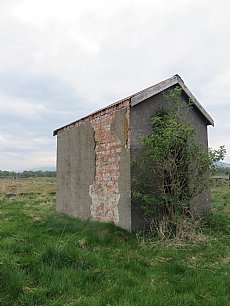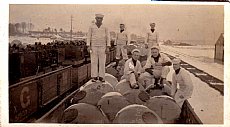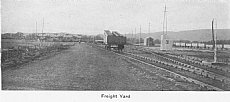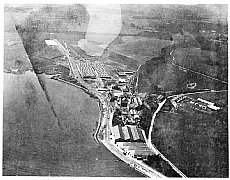WWI Detonator Store, Dalmore near Invergordon
01 October 2020
- News Type:
- Site of the Month
 This brick building is a rare survival of a WWI military building in the Highlands. It was built to store detonator parts for mines at the U.S. Navy base at Dalmore. Towards the end of WWI the U.S. Navy set up two bases in the Highlands, one at Dalmore Distillery and one in Inverness. Components were shipped from the US. In the case of Dalmore, they arrived by ship to Kyle of Lochalsh, and then were transported by rail to Dalmore, where a special branch line was constructed. The distillery buildings were taken over, and three large warehouses for assembling mines and storing components were built in the field to the west of the distillery. Numerous sidings were constructed at the site. Once complete, the mines were sent by rail to Invergordon, on another specially constructed railway line, and then placed on boats. Mines were then laid between Orkney and Norway in an operation known as the Northern Barrage. While most were laid by the U.S., the British also laid a number of mines as well.
This brick building is a rare survival of a WWI military building in the Highlands. It was built to store detonator parts for mines at the U.S. Navy base at Dalmore. Towards the end of WWI the U.S. Navy set up two bases in the Highlands, one at Dalmore Distillery and one in Inverness. Components were shipped from the US. In the case of Dalmore, they arrived by ship to Kyle of Lochalsh, and then were transported by rail to Dalmore, where a special branch line was constructed. The distillery buildings were taken over, and three large warehouses for assembling mines and storing components were built in the field to the west of the distillery. Numerous sidings were constructed at the site. Once complete, the mines were sent by rail to Invergordon, on another specially constructed railway line, and then placed on boats. Mines were then laid between Orkney and Norway in an operation known as the Northern Barrage. While most were laid by the U.S., the British also laid a number of mines as well.

Invergordon Museum
The story of the Highland’s role has been gathered together by several community groups, and published in a new book (Harvey and Kruse 2020). The book was able to make use of a number of photographs donated to Invergordon Museum by the descendants of a relation of a US sailor, Wayne Abbott, who served at Dalmore.

The detonator store was situated near railway sidings, but well away from other buildings. Its construction with a thick wall, but less substantial roof appears to be designed to force any unexpected explosion upwards.
Foundations for much of the large sheds can still be discerned in the fields, though some were built over for World War II buildings when the distillery was again taken over by the military, this time by the RAF as a technical area, or for more modern distillery warehouses. The long pier is locally known as the Yankee pier. Although begun during WWI, with the aim to ship directly rather than going via Invergordon, it was still under construction at the end of the war.
The base was only in operation for months, but after the Armistice the real problem of retrieving the mines began. In March 1919 the facility at Dalmore was handed over to the Admiralty who used the base for its own mine retrieving actions, and presumably the detonator store as well.
 The building is important as one of the few remaining buildings associated with WWI activity in the area, and part of a little publicised collaboration in the late wartime years. It is also a good example of a detailed community research project.
The building is important as one of the few remaining buildings associated with WWI activity in the area, and part of a little publicised collaboration in the late wartime years. It is also a good example of a detailed community research project.
Further information
Samsin, Carolyn 2020 ‘US Navy Base 17 Dalmore’, in Harvey, Adrian and Kruse, Susan (eds) The Northern Barrage. The Fence across the North Sea in WWI, Inverness Local History Forum: Inverness
http://www.archhighland.org.uk/wartime-dalmore.asp
Site of the Month Archive
- 10/04/2021 Easter Raitts township
- 02/03/2021 Lower Slackbuie, Inverness (ASDA) Neolithic site
- 01/02/2021 Balnuaran of Clava cairns
- 04/01/2021 Wilkhouse Inn
- 02/12/2020 Spinningdale Cotton Mill
- 02/11/2020 Skibo A Canadian Forestry Camp
- 01/10/2020 WWI Detonator Store, Dalmore near Invergordon
- 03/09/2020 Mesolithic Shell Midden at Sand, Wester Ross
- 08/08/2020 Kinbeachie Neolithic settlement
- 01/07/2020 Armadale Cist Burial and Stone & Timber Complex


